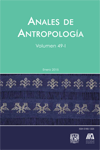Living amongst volcanoes, forests, and water: The ancient Santa Cruz Atizapan islanders
Main Article Content
Abstract
The Valley of Toluca has particularities in which the presence of surrounding volcanoes and shallow water bodies constitute a relevant landscape. It is worth mentioning that the Lerma river, which crosses the valley from the southeast to the northwest, conforms the most extensive basin in México. The region has a long history,going back to the Formative period and covering at least 3,000 years. Notwithstanding, the history of the Valley of Toluca —rich in diverse biotic resources,including lacustrine, terrestrial, and forest environments— has been characterized by diverse historical trajectories and rhythms. Of those processes, one trajectory stands out, developed by the human groups who colonized and inhabited the shallow water-swamp environment ca. 1 500 years ago. Because of the climatic changes, these lacustrine populations were forced to abandon their unique,well adapted lifestyle around AD 900/1000.
This article covers the emergence, apogee, and abandonment of a lacustrine society which developed in Santa Cruz Atizapan, located in the Chignahuapan swamp, in the southernmost lacustrinearea of the Toluca valley. It stresses the important role which this ecological zone played in the history of the region. It also mentions the idiosyncrasy of this lifestyle, its strength and vulnerability.
Downloads
Article Details
Esta revista usa una licencia CC del tipo CC BY-NC-ND 3.0. Se maneja bajo el esquema de acceso abierto, con una licencia Creative Commons Attribution-NonCommercial-NoDerivs 3.0 Unported.
